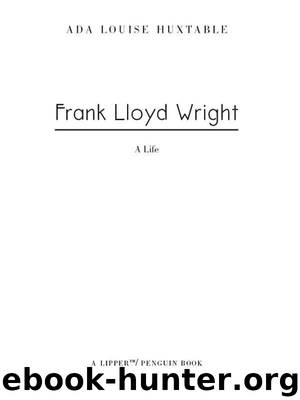Frank Lloyd Wright by Ada Louise Huxtable

Author:Ada Louise Huxtable
Language: eng
Format: epub
Publisher: Penguin Publishing Group
Published: 1999-04-26T04:00:00+00:00
7
HE PUT NO HEADSTONE on the grave. Why mark the spot “where desolation ended and began?” he wrote in the Autobiography.“After the first terrible anguish,” he could no longer imagine her presence, or feel her spirit. The horror of the event had numbed his senses—“the blow was too severe.” He refused to let his mother come and sent his son away.
He slept in a small room behind the studio, the nights “filled with strange, unreasoning terrors. . . . The gaping black hole left by the fire in the beautiful hillside seemed a charred and ugly scar upon my own life—on all life.” There are traumas too deep to deal with, guilt, real or imagined, too hard to face, losses too great to mourn. He suffered from boils on his back and neck. He thought he was going blind. After a while, he returned to the house he kept in Chicago and lived alone, with a housekeeper.
He vowed to rebuild Taliesin, and it was the rebuilding that saved him. “In action there is release from anguish,” he wrote. “Work only was bearable.” He redesigned the places where the murders had taken place to exorcise memory. A new wing was built, with another great fireplace, and an outdoor stone loggia added that looked out to the Helena Valley. “Steadily, stone by stone, board by board, Taliesin II began to rise from the ashes of Taliesin I.”
Every aspect of the tragedy had been exploited by the newspapers; those who knew nothing of his architecture knew everything about the scandals and sorrows of his personal life. Mail came from all over, much of it sympathetic. He said he tied the letters in a bundle, unread, and burned them; it is more likely that they were screened first by his staff. But there was one letter that he read and responded to, written in a tone of such sensitive understanding that he became curious about the sender. The writer was a wealthy divorcée, Maud Miriam Noel, who had been living in Paris as an expatriate and sculptor until the start of the First World War had forced her return. Miriam Noel, as she preferred to be known—she had dropped the old-fashioned Maud—was exactly the kind of cosmopolitan and “liberated” woman Wright would find interesting and consoling, and he arranged to meet her at his Chicago office.
He was immediately intrigued. She was a worldly woman of forty-five, two years younger than he was, and far more attractive than he had expected. Like Wright, she was a master of self-image. Her dress was “artistic” in the current mode; she favored turbans, scarves, ropes of beads and furs adorning long gowns and wraps. She wore and played with a monocle as they spoke, smoked cigarettes, which he helped her light, and exuded an air of sophistication and mystery that was only heightened when she spoke of a “luckless” love affair, which immediately struck a symbiotic note with his own unhappiness.
Miriam Noel has been described as pretty, with an expressive face and large eyes.
Download
This site does not store any files on its server. We only index and link to content provided by other sites. Please contact the content providers to delete copyright contents if any and email us, we'll remove relevant links or contents immediately.
Cecilia; Or, Memoirs of an Heiress — Volume 3 by Fanny Burney(31463)
Cecilia; Or, Memoirs of an Heiress — Volume 2 by Fanny Burney(31413)
Fanny Burney by Claire Harman(26249)
We're Going to Need More Wine by Gabrielle Union(18641)
Plagued by Fire by Paul Hendrickson(17117)
Cat's cradle by Kurt Vonnegut(14773)
All the Missing Girls by Megan Miranda(14772)
Bombshells: Glamour Girls of a Lifetime by Sullivan Steve(13692)
Leonardo da Vinci by Walter Isaacson(12810)
4 3 2 1: A Novel by Paul Auster(11802)
For the Love of Europe by Rick Steves(11545)
Adultolescence by Gabbie Hanna(8595)
The remains of the day by Kazuo Ishiguro(8407)
Note to Self by Connor Franta(7455)
Diary of a Player by Brad Paisley(7270)
Giovanni's Room by James Baldwin(6818)
What Does This Button Do? by Bruce Dickinson(5936)
Born a Crime by Trevor Noah(5101)
Ego Is the Enemy by Ryan Holiday(4963)
